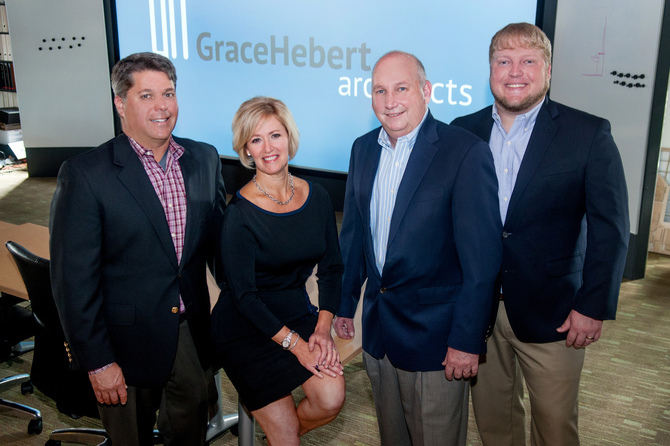GRACEHEBERT ARCHITECTS
ARCHITECTURE FIRM LEVERAGES TECHNOLOGY TO OFFER CLIENT-CENTERED DESIGN
Special Advertising Feature
REQUEST MORE INFORMATION
GRACEHEBERT ARCHITECTS brings projects to life with holistic, immersive design. The firm, which this year celebrates its 50th anniversary, has long been an industry innovator, adapting to the ever-changing architectural landscape and seamlessly integrating emerging technologies.
Established in 1967, GraceHebert provides architecture, interior architectural design, programming and master planning services for a variety of industries. The firm has offices in both Baton Rouge and New Orleans, and serves the southern United States from Arizona to Florida.
Using state-of-the-art 3D modeling—as opposed to typical two-dimensional renderings—GraceHebert Architects has revolutionized the client experience. While embracing innovation at every level, the company has remained faithful to its collaborative and client-centered philosophy.
“We’re a client-focused company, so we really engage our clients in the design side,” says Jerry Hebert, president of GraceHebert Architects. “We’ve engaged technology at a whole different level to create a process that is different from anyone else’s.”
Through design technology available in GraceHebert’s one-of-a-kind Building Information Modeling (BIM) Lab, the team develops virtual 3D models that effectively immerse clients in their future facilities. The holistic, immersive design process also identifies design conflicts or challenges before construction. This minimizes the impact on a project’s construction timeline and budget while also enhancing client collaboration and satisfaction.
“We’re able to create their vision and show it to the client virtually,” says Partner Adam Fishbein. “They experience what they’re getting, down to the colors and finishes. They can confirm that we have captured their ideas before it’s built. There’s a level of comfort in being able to do that.”
Allowing clients to virtually step inside a design in progress results in a better final product and increased client confidence, according to Hebert. As proof, approximately 70% of the company’s clientele represents repeat business. “With holistic, immersive design, our clients think about their projects in a way they wouldn’t have otherwise,” he says. “Whether they’re investing in a restroom expansion or Alex Box Stadium, the BIM Lab is a powerful tool.”
Approaching a project holistically also includes integrating interior design from the outset.
“Our interior designers work hand-in-hand with our architects from the beginning,” says Partner Kriste Rigby. “We look at all facets of the project, inside-out as well as outside-in, so our clients’ needs are met from every perspective.”
Partner David Hebert adds that 3D modeling can also help support fundraising efforts for capital projects, ensuring broader client and community buy-in.
“Fundraising is often all about the visual,” he says. “If we can show our clients what they’re going to get, we can provide them with ammunition to help them reach their goals.”
GraceHebert specializes in K-12, corporate, ecclesiastical, interiors, health care and criminal justice design, with a portfolio that includes everything from state-of-the-art hospitals to secure courthouses. The firm’s recent projects include the award-winning Cajun Industries office expansion, the new St. George Catholic Church in Baton Rouge, LSU’s top-ranked Alex Box Stadium and an expansion of the LSU Student Recreation Center that inspires personal health and wellness. The firm’s design of the new Lee High School, a 21st-century prototype school that supports project-based learning, illustrates the broad impact of GraceHebert’s work.
“Lee High School is a game changer in this community. It’s the first true 21st-century high school in Louisiana,” Jerry Hebert says. “Every space is a technology-rich, collaborative space. It has the opportunity to change the face of education in our community.”
Even after 50 years of success designing facilities that enhance community life, GraceHebert isn’t resting on its laurels. The firm currently plans to expand over the next five years. “We want to be a regional powerhouse,” Hebert says. “Our process is unique and engaging, so if we can take it to other locations in the Southeast with the right partners, it will enhance our regional diversity.”
Despite its plans for expansion, however, the firm remains rooted in Baton Rouge, where its headquarters are located in a renovated historic downtown building. “We work with the business community, parishioners, K-12, Southern University and LSU, and health care,” says Fishbein. “Our engagement is not strictly a single vertical—we have a very broad-based practice that is deeply involved in the Baton Rouge community.”
Strong leadership and a talented staff can be credited for that involvement as well as for the company’s overall success.
“We’ve hired young architects and interior designers with incredible skills, and we’ve got a knowledgeable staff with great longevity. People come here and stay here,” Hebert says. “Our staff is constantly pushing the envelope and trying to improve outcomes—that’s second nature to us.
“It takes technology to do what we do,” Hebert continues. “But it also takes people to use that technology and to care deeply about the projects delivered.”
AT A GLANCE:
TOP EXECUTIVES: Jerry Hebert, Adam Fishbein, Kriste Rigby and David Hebert
YEAR FOUNDED: 1967
NO. OF EMPLOYEES: 30
PHONE: (225) 338-5569
WEBSITE: gracehebert.com
EMAIL: contact@gracehebert.com
FACEBOOK:
GraceHebert Architects


